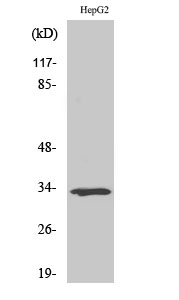ODC Polyclonal Antibody
- SPECIFICATION
- CITATIONS
- PROTOCOLS
- BACKGROUND

Application
| WB, IHC-P |
|---|---|
| Primary Accession | Q9BQT8 |
| Reactivity | Human, Mouse, Rat |
| Host | Rabbit |
| Clonality | Polyclonal |
| Calculated MW | 33303 Da |
| Gene ID | 89874 |
|---|---|
| Other Names | SLC25A21; ODC; Mitochondrial 2-oxodicarboxylate carrier; Solute carrier family 25 member 21 |
| Dilution | WB~~Western Blot: 1/500 - 1/2000. Immunohistochemistry: 1/100 - 1/300. ELISA: 1/40000. Not yet tested in other applications. IHC-P~~N/A |
| Format | Liquid in PBS containing 50% glycerol, 0.5% BSA and 0.09% (W/V) sodium azide. |
| Storage Conditions | -20℃ |
| Name | SLC25A21 |
|---|---|
| Synonyms | ODC |
| Function | Transports dicarboxylates across the inner membranes of mitochondria by a counter-exchange mechanism (PubMed:11083877). Can transport 2-oxoadipate (2-oxohexanedioate), 2-oxoglutarate, adipate (hexanedioate), glutarate, and to a lesser extent, pimelate (heptanedioate), 2-oxopimelate (2-oxoheptanedioate), 2-aminoadipate (2- aminohexanedioate), oxaloacetate, and citrate (PubMed:11083877). Plays a central role in catabolism of lysine, hydroxylysine, and tryptophan, by transporting common metabolite intermediates (such as 2-oxoadipate) into the mitochondria, where it is converted into acetyl-CoA and can enter the citric acid (TCA) cycle (Probable). |
| Cellular Location | Mitochondrion inner membrane; Multi-pass membrane protein |
| Tissue Location | Expressed in placenta, gall bladder and colon. |

Thousands of laboratories across the world have published research that depended on the performance of antibodies from Abcepta to advance their research. Check out links to articles that cite our products in major peer-reviewed journals, organized by research category.
info@abcepta.com, and receive a free "I Love Antibodies" mug.
Provided below are standard protocols that you may find useful for product applications.
Background
Transports C5-C7 oxodicarboxylates across the inner membranes of mitochondria. Can transport 2-oxoadipate, 2- oxoglutarate, adipate, glutarate, and to a lesser extent, pimelate, 2-oxopimelate, 2-aminoadipate, oxaloacetate, and citrate.
If you have used an Abcepta product and would like to share how it has performed, please click on the "Submit Review" button and provide the requested information. Our staff will examine and post your review and contact you if needed.
If you have any additional inquiries please email technical services at tech@abcepta.com.













 Foundational characteristics of cancer include proliferation, angiogenesis, migration, evasion of apoptosis, and cellular immortality. Find key markers for these cellular processes and antibodies to detect them.
Foundational characteristics of cancer include proliferation, angiogenesis, migration, evasion of apoptosis, and cellular immortality. Find key markers for these cellular processes and antibodies to detect them. The SUMOplot™ Analysis Program predicts and scores sumoylation sites in your protein. SUMOylation is a post-translational modification involved in various cellular processes, such as nuclear-cytosolic transport, transcriptional regulation, apoptosis, protein stability, response to stress, and progression through the cell cycle.
The SUMOplot™ Analysis Program predicts and scores sumoylation sites in your protein. SUMOylation is a post-translational modification involved in various cellular processes, such as nuclear-cytosolic transport, transcriptional regulation, apoptosis, protein stability, response to stress, and progression through the cell cycle. The Autophagy Receptor Motif Plotter predicts and scores autophagy receptor binding sites in your protein. Identifying proteins connected to this pathway is critical to understanding the role of autophagy in physiological as well as pathological processes such as development, differentiation, neurodegenerative diseases, stress, infection, and cancer.
The Autophagy Receptor Motif Plotter predicts and scores autophagy receptor binding sites in your protein. Identifying proteins connected to this pathway is critical to understanding the role of autophagy in physiological as well as pathological processes such as development, differentiation, neurodegenerative diseases, stress, infection, and cancer.


